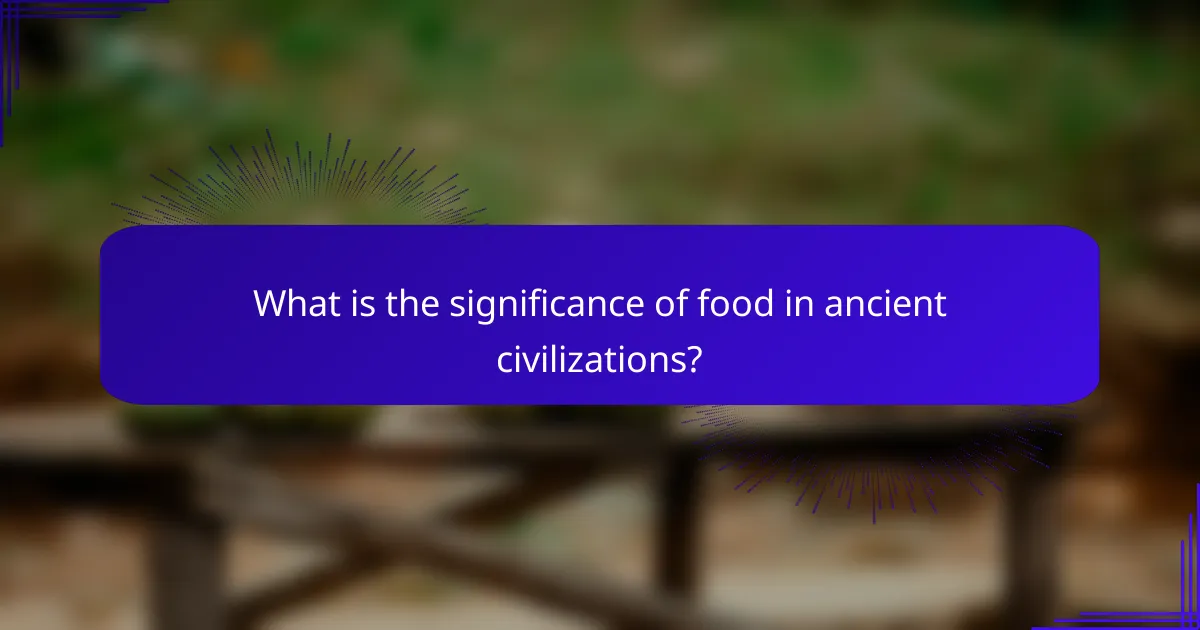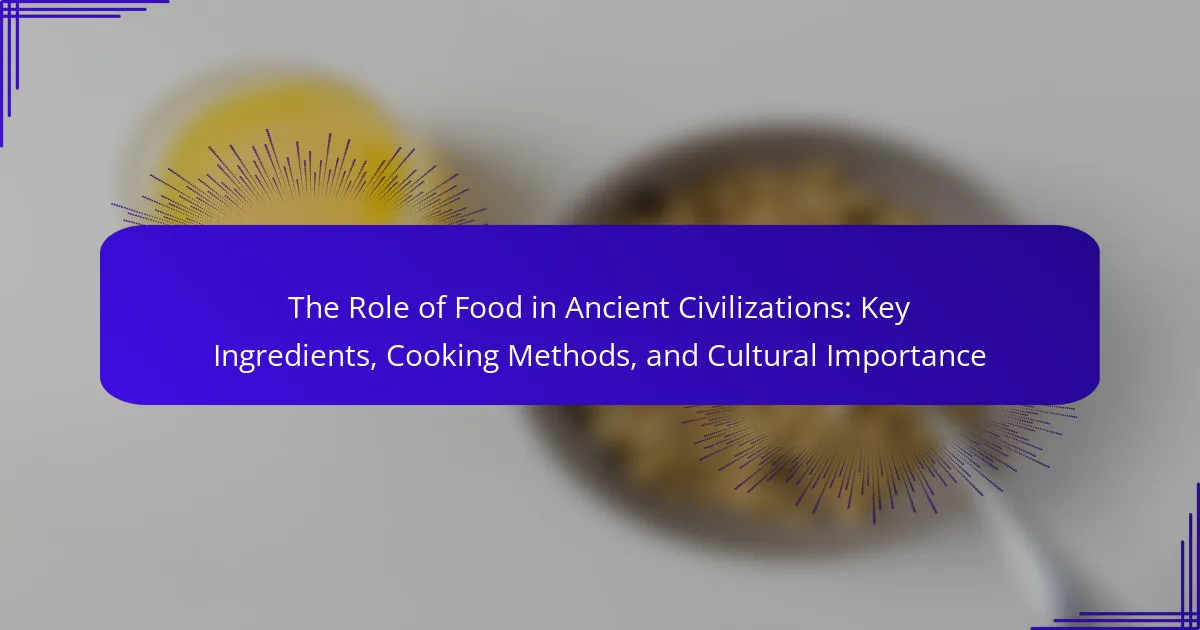
What is the significance of food in ancient civilizations?
Food was essential in ancient civilizations for sustenance, cultural identity, and social organization. It provided the necessary nutrients for survival and growth. Different civilizations developed unique agricultural practices based on their environment. For example, the Egyptians relied on the Nile for irrigation, cultivating crops like wheat and barley. Food also played a role in religious rituals and celebrations. Offerings to deities often included grains and livestock. Additionally, food facilitated trade between civilizations, promoting economic growth. The exchange of spices, grains, and other goods enriched cultures. Overall, food was a cornerstone of social structure and cultural heritage in ancient societies.
How did food influence daily life in ancient cultures?
Food significantly influenced daily life in ancient cultures by shaping social structures, economic activities, and religious practices. It provided sustenance that was essential for survival. Different cultures developed unique agricultural practices based on their environment. For instance, Mesopotamians cultivated barley and wheat, while the Mayans relied on maize. Food also served as a medium for social interaction. Shared meals fostered community bonds and rituals. Additionally, food played a crucial role in religious ceremonies. Many cultures offered food to deities as a form of worship. The trade of food items contributed to economic development and cultural exchange. Overall, food was central to the organization and functioning of ancient societies.
What were the primary food sources for ancient civilizations?
Ancient civilizations primarily relied on agriculture for food sources. They cultivated grains such as wheat, barley, and rice. Vegetables like beans, lentils, and peas were also significant. Fruits such as figs, dates, and olives contributed to their diets. Livestock provided meat, milk, and eggs. Fishing supplemented their food supply in coastal areas. These food sources were crucial for sustaining large populations. Archaeological evidence supports the importance of these staples in ancient diets.
How did geography affect food availability and consumption?
Geography significantly influenced food availability and consumption in ancient civilizations. Different regions offered varying climates, soils, and resources. Fertile river valleys supported agriculture, enabling the growth of staple crops. For example, the Nile River in Egypt provided irrigation for wheat and barley. In contrast, arid areas limited farming, leading to reliance on trade or foraging. Coastal regions benefited from abundant seafood, shaping diets and culinary practices. Mountainous terrains restricted crop diversity and accessibility. Consequently, geography dictated not only what foods were available but also how cultures developed their cooking methods and dietary customs.
What role did food play in social and religious practices?
Food served as a central element in social and religious practices across ancient civilizations. It facilitated community bonding during communal meals and celebrations. Ritualistic offerings often included food to deities, symbolizing gratitude and devotion. Specific foods held sacred meanings, such as bread in [censured] and rice in Hinduism. Festivals frequently revolved around food, highlighting agricultural cycles and seasonal changes. Sharing food during rituals reinforced social hierarchies and cultural identity. Historical records indicate that food choices reflected local resources and beliefs. Archaeological findings show food remnants at ancient religious sites, confirming its significance in worship.
How were meals integrated into religious ceremonies?
Meals were integrated into religious ceremonies as offerings to deities. These offerings symbolized gratitude and devotion. In many ancient cultures, specific foods were deemed sacred. For example, bread and wine were central to Christian rituals. In Hinduism, rice and ghee were often used in pujas. Meals served during ceremonies fostered community bonds. Participants shared food to enhance social cohesion. Historical texts document these practices across various civilizations. Archaeological findings support the significance of food in rituals.
What social hierarchies were reflected in food consumption?
Social hierarchies in ancient civilizations were often reflected in food consumption patterns. Higher social classes consumed more elaborate and diverse foods. They had access to rare ingredients, such as spices and exotic meats. This access signified wealth and status. In contrast, lower classes primarily ate staple foods like grains and vegetables. Their diets were limited and less varied. Rituals and feasts also highlighted social divisions. Elite members hosted grand banquets with luxurious dishes. Archaeological evidence shows distinct dining practices across social strata. For example, pottery styles indicate the quality of food served to different classes. Overall, food consumption served as a clear indicator of social hierarchy.

What were the key ingredients used in ancient cuisines?
Key ingredients used in ancient cuisines included grains, legumes, fruits, vegetables, and meats. Grains such as wheat and barley formed the basis of many diets. Legumes like lentils and chickpeas provided essential protein. Fruits, including dates and figs, were commonly consumed for their sweetness. Vegetables such as onions and garlic added flavor and nutrition. Meats from domesticated animals and wild game were significant sources of sustenance. These ingredients varied by region, reflecting local agriculture and climate. Historical texts and archaeological findings support the diversity and significance of these ingredients in ancient diets.
What staple foods were common across various ancient civilizations?
Staple foods common across various ancient civilizations included grains, legumes, and tubers. Wheat was a primary staple in ancient Egypt and Mesopotamia. Rice served as a fundamental food in ancient China and India. Corn was essential for the diets of Mesoamerican civilizations like the Maya and Aztecs. Barley was widely consumed in ancient Greece and Rome. Legumes such as lentils and chickpeas were common in the diets of the Mediterranean and Near Eastern cultures. Potatoes were a staple in the Andean civilizations of South America. These foods provided essential nutrients and formed the basis of daily diets across different regions.
How did grains shape the diets of ancient peoples?
Grains were fundamental to the diets of ancient peoples. They provided essential carbohydrates, which served as a primary energy source. Civilizations such as the Mesopotamians relied heavily on barley and wheat. These grains were cultivated in large quantities, enabling population growth and urbanization. Archaeological evidence shows that grains were often ground into flour for bread-making. Bread became a staple food item across many cultures. Additionally, grains were used in brewing beer, which played a significant role in social rituals. The storage of grains allowed for food security during lean seasons. Overall, grains shaped dietary practices and influenced social structures in ancient civilizations.
What role did fruits and vegetables play in nutrition?
Fruits and vegetables played a crucial role in nutrition by providing essential vitamins, minerals, and dietary fiber. They contributed to overall health and well-being in ancient civilizations. For instance, fruits like berries and vegetables such as leafy greens were rich in antioxidants and nutrients. These food sources helped prevent diseases and promote longevity. Historical records indicate that ancient diets heavily relied on fruits and vegetables for sustenance. In many cultures, they were staples that supported energy needs and bodily functions. The consumption of these foods was linked to improved digestion and better immune responses.
Which unique ingredients were specific to certain cultures?
Unique ingredients specific to certain cultures include saffron in Persian cuisine, miso in Japanese cooking, and quinoa in Andean cultures. Saffron, derived from the Crocus sativus flower, is prized for its flavor and color. It has been used in Persian dishes for centuries, particularly in rice and stews. Miso, a fermented soybean paste, is fundamental in Japanese cuisine. It serves as a base for soups and marinades, reflecting the country’s culinary traditions. Quinoa, a grain native to the Andes, was a staple for the Inca civilization. It is celebrated for its nutritional value and versatility in various dishes. Each ingredient illustrates the cultural significance and unique agricultural practices of its respective region.
What were the distinctive spices and herbs used in ancient recipes?
Distinctive spices and herbs used in ancient recipes included cumin, coriander, and dill. Cumin was widely utilized in ancient Egyptian and Mesopotamian cooking for its flavor and preservative qualities. Coriander, known for its aromatic properties, was favored in Roman and Greek cuisines. Dill was commonly used for seasoning fish and pickling in various cultures. Other notable herbs included mint, used in ancient Mediterranean dishes, and thyme, valued for its medicinal properties. These spices and herbs played crucial roles in flavoring food and were often associated with cultural rituals and practices. Historical texts, such as those from ancient Egypt and Greece, document the use of these ingredients in everyday cooking and ceremonial meals.
How did trade influence the introduction of new ingredients?
Trade significantly influenced the introduction of new ingredients by facilitating the exchange of goods between different cultures. Through trade routes, such as the Silk Road, ingredients like spices and herbs were transported across vast distances. This exchange introduced new flavors and culinary techniques to various societies. For example, the introduction of black pepper from India to Europe transformed European cuisine. Additionally, trade allowed for the sharing of agricultural practices, enabling the cultivation of new crops in different regions. Historical records show that trade expanded the variety of available ingredients, enhancing food diversity in ancient civilizations.

What cooking methods were employed in ancient times?
Ancient times employed several cooking methods, including roasting, boiling, and baking. Roasting involved cooking food over an open flame or hot coals. This method was common for meats and vegetables. Boiling used water or broth to cook food in pots made from clay or metal. Baking was achieved in clay ovens, often used for bread and pastries. Other methods included steaming and drying, which preserved food for longer periods. Archaeological evidence supports these cooking techniques, such as findings of ancient hearths and cooking vessels. Historical records also describe these methods in various civilizations, including the Egyptians and Romans.
How did ancient civilizations prepare and cook their food?
Ancient civilizations prepared and cooked their food using various methods. They utilized open flames for roasting and boiling food in pots. Clay ovens were common for baking bread and other items. Many civilizations employed techniques like smoking and drying to preserve food. They also used grinding stones to process grains into flour. Cooking methods often varied based on available resources and cultural practices. For example, the Egyptians used a combination of baking and boiling, while the Chinese developed stir-frying techniques. Archaeological evidence supports these practices, showcasing tools and remnants of ancient cooking methods.
What tools and techniques were commonly used in food preparation?
Common tools and techniques used in food preparation included grinding stones, knives, and cooking pots. Grinding stones were essential for processing grains and spices. Knives were utilized for cutting meats and vegetables. Cooking pots, often made of clay or metal, were used for boiling and stewing food. Fire was a primary technique for cooking, providing heat for various methods. Baking was achieved using hot stones or in clay ovens. Fermentation was a technique for preserving food and enhancing flavors. These tools and techniques were fundamental in ancient civilizations for meal preparation and preservation.
How did cooking methods vary by region and culture?
Cooking methods varied significantly by region and culture due to local resources and traditions. In ancient Mesopotamia, for instance, people used clay ovens for baking bread. This technique was influenced by the availability of clay and grains. In contrast, ancient Chinese cultures utilized woks and steamers, reflecting their agricultural practices and preference for stir-frying.
Similarly, indigenous peoples in the Americas employed methods like roasting and smoking, utilizing open fires and available game. In Mediterranean regions, grilling and boiling were common, aided by abundant olive oil and fresh vegetables. Each region’s unique environment shaped its cooking practices, leading to diverse culinary traditions that are still evident today.
What innovations in cooking emerged from ancient practices?
Ancient practices led to several innovations in cooking. The use of fire for cooking was a major breakthrough. This allowed for roasting, boiling, and baking, enhancing flavor and digestibility. The development of pottery enabled the creation of vessels for cooking and storage. Techniques such as fermentation emerged, leading to the production of bread and alcoholic beverages. Additionally, the introduction of spices and herbs improved food preservation and flavor. Ancient civilizations also pioneered methods like drying and smoking to extend the shelf life of food. These innovations laid the foundation for modern culinary practices.
How did advancements in cooking techniques affect food preservation?
Advancements in cooking techniques significantly improved food preservation methods. Techniques such as drying, smoking, and fermenting allowed for longer storage of perishable items. For example, drying fruits and meats reduced moisture content, inhibiting bacterial growth. Smoking added flavor while also creating a protective barrier against spoilage. Fermentation transformed foods into more stable forms, enhancing shelf life through the production of acids. Historical evidence shows that ancient civilizations, like the Egyptians and Chinese, utilized these methods to store food for months. This innovation in cooking techniques directly contributed to the sustainability of food supplies in various cultures.
What legacy do ancient cooking methods leave in modern cuisine?
Ancient cooking methods significantly influence modern cuisine. Techniques such as roasting, fermenting, and smoking are still widely used today. For example, roasting meats over an open flame dates back to prehistoric times. This method enhances flavor while preserving moisture. Fermentation, utilized by ancient cultures, is essential for products like yogurt and bread. Smoking foods for preservation and flavor originated in early civilizations. These methods have shaped contemporary culinary practices and ingredient choices. The legacy of ancient cooking methods is evident in global cuisines that celebrate these time-honored techniques.
How can we apply lessons from ancient food practices today?
We can apply lessons from ancient food practices today by incorporating traditional cooking methods and ingredients. Many ancient civilizations utilized fermentation, which enhances flavor and preserves food. For example, the Chinese developed soy sauce through fermentation, a practice that improves food safety and nutrition. Ancient grains like quinoa and barley were staples due to their high nutritional value. Modern diets can benefit from these grains, which are rich in protein and fiber.
Additionally, ancient food practices often emphasized seasonal and local sourcing. This approach supports sustainability and reduces carbon footprints. Historical diets were diverse, promoting a variety of nutrients. A diverse diet can improve overall health and prevent chronic diseases.
Incorporating these practices can lead to healthier eating habits and a more sustainable food system. By learning from ancient civilizations, we can create a more balanced and nutritious contemporary diet.
What are some traditional recipes that can be recreated?
Traditional recipes that can be recreated include dishes like hummus, paella, and risotto. Hummus dates back to ancient Middle Eastern civilizations and is made from chickpeas, tahini, lemon juice, and garlic. Paella originates from Spain and combines rice, saffron, and various meats or seafood. Risotto is an Italian dish that features Arborio rice cooked slowly in broth, often with vegetables or seafood. These recipes are not only delicious but also reflect the culinary traditions of their respective cultures. Each recipe can be adapted with modern ingredients while maintaining its historical essence.
How can understanding ancient food cultures enhance modern diets?
Understanding ancient food cultures can enhance modern diets by providing insights into nutritional practices and ingredient diversity. Ancient civilizations often prioritized local, seasonal ingredients, promoting sustainability. For instance, the Mediterranean diet is rooted in ancient practices emphasizing whole grains, fruits, and vegetables. This diet has been linked to reduced risks of chronic diseases, according to studies published in the Journal of Nutrition. Additionally, ancient methods of food preservation, such as fermentation, are gaining popularity for their health benefits, including improved gut health. By incorporating these traditional practices, modern diets can become more balanced and healthful.
The main entity of the article is food in ancient civilizations, which played a crucial role in sustenance, cultural identity, and social organization. The article explores the significance of food, detailing how geography influenced availability, the primary food sources, and the role of food in social and religious practices. It highlights key ingredients used across various cultures, cooking methods employed, and innovations that emerged from ancient practices. Additionally, it discusses how understanding these ancient food cultures can enhance modern diets by promoting sustainability and nutritional diversity.
